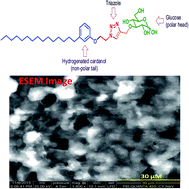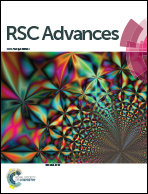Thermotropic gelation induced changes in micropolarity and microviscosity of hydrogel derived from glucose-triazole-hydrogenated cardanol conjugate: a study using fluorescent molecular probe†
Abstract
Glucose triazole cardanol conjugate (GTHCC) is a supergelator in water–methanol (1 : 1) solvent mixture. Environmental scanning electron microscopy (ESEM) and fluorescence molecular probe based techniques were employed to understand the thermotropic gelation induced changes in micropolarity and microviscosity of GTHCC hydrogel in water–methanol (1 : 1) solvent mixture. ESEM analysis has shown the formation of spongy sheet like structures having micrometer size pores inside it. The fluorescence intensity and fluorescence anisotropy measurements of the polarity sensitive probe 8-anilino-1-naphthalene sulfonic acid (ANS) revealed a significant increase in the micropolarity and a significant decrease in the microviscosity of GTHCC hydrogel between the gel and sol phases. Time resolved fluorescence decay analysis of ANS has shown the presence of two different microenvironments in the system and thermotropic microenvironmental changes between gel and sol phases of GTHCC hydrogels.


 Please wait while we load your content...
Please wait while we load your content...